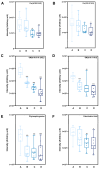Unveiling the Metabolomic Profile of Oily Sensitive Skin: A Non-Invasive Approach
- PMID: 39456816
- PMCID: PMC11507585
- DOI: 10.3390/ijms252011033
Unveiling the Metabolomic Profile of Oily Sensitive Skin: A Non-Invasive Approach
Abstract
Skin barrier impairment is becoming increasingly common due to changes in lifestyle and modern living environments. Oily sensitive skin (OSS) is a condition that is characterized by an impaired skin barrier. Thus, examining the differences between OSS and healthy skin will enable a more objective evaluation of the characteristics of OSS and facilitate investigations of potential treatments. Initially, a self-assessment questionnaire was used to identify patients with OSS. Biophysical measurements and LAST scores were used to determine whether skin barrier function was impaired. Epidermal biophysical properties, including skin hydration, transepidermal water loss (TEWL), sebum content, erythema index (EI), and a* value, were measured with noninvasive instruments. We subsequently devised a noninvasive D-square sampling technique to identify changes in the skin metabolome in conjunction with an untargeted metabolomics analysis with an Orbitrap Q ExactiveTM series mass spectrometer. In the stratum corneum of 47 subjects, 516 skin metabolites were identified. In subjects with OSS, there was an increase in the abundance of 15 metabolites and a decrease in the abundance of 48 metabolites. The participants with OSS were found to have the greatest disruptions in sphingolipid and amino acid metabolism. The results revealed that an impaired skin barrier is present in patients with OSS and offers a molecular target for screening for skin barrier damage.
Keywords: compromised skin barrier; oily sensitive skin; questionnaire; untargeted metabolomics.
Conflict of interest statement
The authors declare no conflicts of interest.
Figures





Similar articles
-
Characterization of oily mature skin by biophysical and skin imaging techniques.Skin Res Technol. 2018 Aug;24(3):386-395. doi: 10.1111/srt.12441. Epub 2018 Feb 13. Skin Res Technol. 2018. PMID: 29441614
-
Questionnaire and Lactic Acid Sting Test Play Different Role on the Assessment of Sensitive Skin: A Cross-sectional Study.Clin Cosmet Investig Dermatol. 2021 Sep 14;14:1215-1225. doi: 10.2147/CCID.S325166. eCollection 2021. Clin Cosmet Investig Dermatol. 2021. PMID: 34548802 Free PMC article.
-
Defective barrier function accompanied by structural changes of psoriatic stratum corneum.J Dermatol. 2014 Feb;41(2):144-8. doi: 10.1111/1346-8138.12393. J Dermatol. 2014. PMID: 24471458
-
Transepidermal water loss and skin surface hydration in the non invasive assessment of stratum corneum function.Derm Beruf Umwelt. 1990 Mar-Apr;38(2):50-3. Derm Beruf Umwelt. 1990. PMID: 2187664 Review.
-
Stratum corneum dysfunction in dandruff.Int J Cosmet Sci. 2012 Aug;34(4):298-306. doi: 10.1111/j.1468-2494.2012.00723.x. Epub 2012 May 17. Int J Cosmet Sci. 2012. PMID: 22515370 Free PMC article. Review.
Cited by
-
Utilizing Untargeted Lipidomics Technology to Elucidate Differences in Lipid Compositions Among Sensitive Dry, Sensitive Oily and Healthy Skin Types.Metabolites. 2025 Apr 26;15(5):292. doi: 10.3390/metabo15050292. Metabolites. 2025. PMID: 40422870 Free PMC article.
References
MeSH terms
LinkOut - more resources
Full Text Sources

